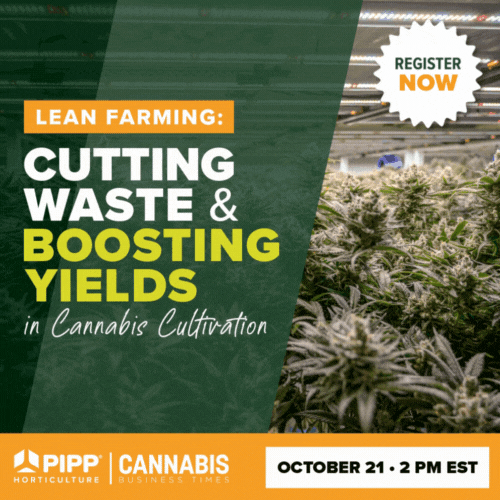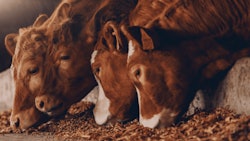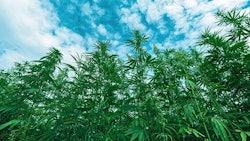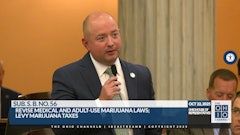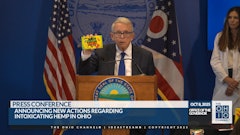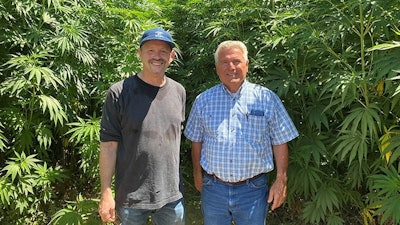
California’s Central Valley hosts a variety of crops, from cereal grains, cotton, and tomatoes to garlic, almonds, and grapes. But the 2021 growing season brought change to the horizon when 30-year hemp industry veteran Lawrence Serbin contracted with cotton grower Tom Pires to cultivate towering fiber hemp during trials on a slice of Central Valley acreage.
More than one industry headline declared 2021 as the year of hemp fiber. But for Serbin, the focus on fiber isn’t new. After a late-1980s college course sparked his interest in hemp’s potential, the entrepreneur envisioned a future for himself in the hemp industry. By 1991, he was the national director of the Business Alliance for Commerce in Hemp (BACH), one of the earliest activist-oriented organizations promoting the return of a legal U.S. hemp industry. Along with hemp activism and advocacy, a decision to enter the hemp fabric business followed.
Serbin founded Hemp Traders in 1993 and earned a respected place in hemp industry history through the years. Today, Hemp Traders is one of the country’s foremost suppliers of hemp textiles and fiber products. It’s been dependent on international markets as U.S.-grown textile-quality fiber hemp remained elusive—but recently, Serbin has taken strides to change that.
Hope Deferred
From day one, offering hemp textiles grown and made in the U.S. has been a personal goal for Serbin. He dreamed of one day seeing California fields filled with fiber hemp yielding textile-quality bast fiber and hurd. But, like other industry trailblazers, he never expected to wait decades.
As the 1990s progressed, Serbin thought U.S. industrial hemp laws would ease, but those years held surprises. Even when California became the first state to legalize medical marijuana in 1996, attitudes toward hemp lagged. “I never thought marijuana was going to be legalized before industrial hemp, but it was. Medical got legalized, then recreational,” Serbin says.
He watched as Canada re-introduced industrial hemp cultivation in 1998, and other countries followed suit. But U.S. and California hemp laws remained remarkably stagnant until 2017, when the California Industrial Farming Act and the subsequent U.S. Agriculture Improvement Act of 2018 (the 2018 Farm Bill) triggered a substantial change.
Serbin’s years of disappointment over not being able to grow hemp seemed behind him, but finding others to share his enthusiasm for cultivating textile-destined fiber hemp proved difficult.
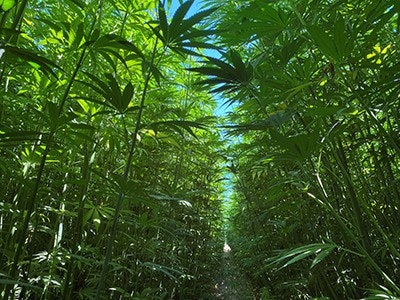
Although Serbin was never a farmer himself, he had been selling hemp seeds to growers in other states through Hemp Traders. In 2019, he gave seeds to several California farmers, who agreed to grow the seed and track performance; however, none of them followed through.
“I knew if we want to grow hemp here, we really need to know how to grow it,” Serbin says. “I’d never grown it, and no one I’d known had grown fiber hemp here.” So, in 2020, he wrote up less-casual growing agreements and provided fiber seed to six people, but a similar story ensued—only one grower planted it but never tracked or harvested the crop.
After two years and no data, Serbin realized that to get fiber hemp grown the way he wanted, he needed to provide the seed and compensate someone to cultivate it. He found his answer in Tom Pires, a hemp-minded 45-year veteran of California’s cotton industry, who served as a farmer-processor representative on the California Department of Food and Agriculture Industrial Hemp Advisory Board when Serbin was the board’s chair from 2017 to 2020.
“We found out that hemp growing very fast outcompetes everything around it, including other hemp.” - Lawrence Serbin, founder, Hemp Traders
At the time, Pires was already actively pursuing hemp as an alternative annual crop for cotton farmers hard hit by water battles and high production costs. As general manager of the West Island Cotton Growers grower cooperative—and a cotton and almond grower himself—he watched California cotton dwindle from 1.6 million acres annually in the late 1970s to less than 180,000 acres by 2020.
But while most would-be hemp growers chased cannabinoids, Pires was different. “There’s nothing wrong with CBD or medical marijuana or recreational marijuana, but that’s not where I’m coming from,” he says. His interest lies in what he knows best: fiber.
A Trial is Born
With Serbin designing experiments and Pires set to grow and collect data, their 2021 California fiber hemp trials got underway. Serbin chose four varieties of Chinese hempseed based on suitability for fiber production and the site’s latitude. He expected a wide genetic variation from the seed, which was not registered or certified by any official agency. “They ended up doing incredibly well, much better than I ever anticipated they would,” Serbin shares.
Pires selected a 10-acre field on his San Joaquin Valley farm based on well-drained, light-textured, sandy-loam soil. Then, he worked the field and irrigated it with sprinklers before planting.
The team used a conventional grain drill, like that used for barley or wheat, to plant nine plots of seed designed to capture varietal performance and optimal planting densities. At four-tenths of an acre each, the plots totaled 3.6 acres of fiber hemp—a modern-day first for Central Valley.
The first planting took place March 5, 2021, as an exercise in how early they could plant successfully. Serbin and Pires planted the remaining plots April 2, 2021. Pires says seeding rates for the four March plots ranged from 40 to 75 pounds of seed per acre, but seed densities increased to as much as 180 pounds per acre for the April planting.
To Pires’s surprise, the first planting germinated exceptionally well despite the early March date and soil temperatures near 55 degrees Fahrenheit. Plots where seedlings emerged in unison engaged in healthy competition, growing tall together, and plots with staggered germination saw late arrivals die out at the feet of those that emerged early. “We found out that hemp growing very fast outcompetes everything around it, including other hemp,” Serbin says.
Raising California Fiber
California’s Central Valley holds 75% of the state’s irrigated land. Though the Central Sierra snowpack was promising earlier this winter, that quickly changed. According to the state’s department of water resources, drought recovery remains tenuous. With irrigation the norm for all crops grown in the Central Valley, water requirements are crucial to any crop’s success — including hemp.
Pires opted for above-ground drip irrigation incorporating lay-flat tubing for the historic trials. Instead of a soil moisture monitoring system, he took the old-school approach: He irrigated when plants were “asking for water,” evidenced by mid-morning wilting and other signs.
Early on, he irrigated young plants at about two-week intervals. As the crop grew bigger and summer temperatures rose, Pires did short irrigation runs twice a week. He monitored and measured water use closely so the team could compare fiber hemp with nearby cotton on similar drip irrigation. Over the season, Pires found the hemp used about 20% less water than the cotton crop did.
“The total amount of water on that first March 5 planting on those four varieties was 19 to 20 inches of water, including the pre-irrigation, which is kind of amazing,” Pires shares. In comparison, he says drip-irrigated cotton uses 24 to 28 inches, depending on the soil. (Envision that depth of water covering the field.)
As cannabinoid and hemp grain growers have learned, optimal hemp production requires proper nutrition. Pires reports feeding 180 pounds of actual nitrogen per acre over the season via UN32 liquid nitrogen in the drip. He typically runs 200 to 250 pounds per acre per season on cotton.
RELATED: 10 Building Blocks to Hemp Nutrition
The team used no herbicides or pesticides, even though fiddleneck weeds typically plague the field. Serbin says the hemp grew so fast, it shut down weeds immediately. Pires saw minimal pest damage on leaves, despite reports of severe pest pressure on area CBD crops. Many birds, bees, and other beneficial insects found their way to the site.
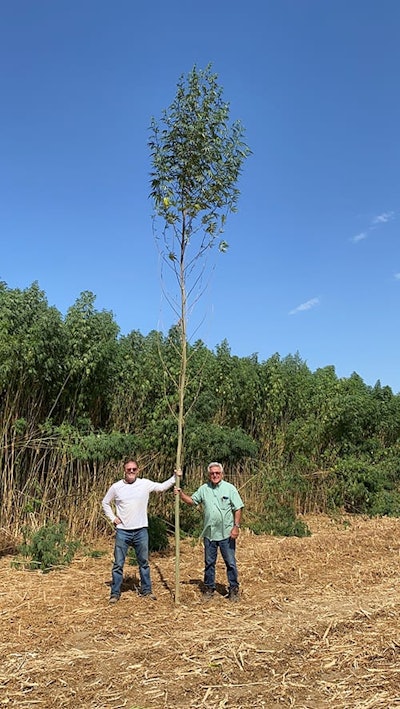
Height proved the greatest cultivation challenge. The plants grew much taller than anticipated—Serbin estimates 20 feet on average. Not one to pass up opportunity, Serbin filed with the Guinness World Records to recognize one plant as the world’s tallest hemp plant. (The submission is still under review. There is currently no world record set for the tallest hemp plant.)
At the time of submission, the plant was 24 feet 1 5/8 inches tall, and it kept growing. Pires says some others surpassed it by harvest time.
After a small practice harvest in July, the full harvest of the March planting came in late August. A company wanting to test their equipment on fiber hemp helped. Part of the harvest involved a silage chopper, which mows and chops the stalks.
Serbin says the silage chopper worked surprisingly well on hemp, especially with hurd in mind, but not for the long fibers preferred for premium hemp textiles. “When you chop the fibers into smaller pieces, you’re lowering their value,” he adds.
The equipment company also tested a sickle bar mower that was slightly modified to handle the height and volume of the plants and accommodate the long fiber harvests that premium hemp textiles demand. Like making hay, the sickle bar simply cut plants down to dry in the field. Pires says the dry Central Valley climate was a perfect match.
The team explains their goal with fiber hemp was to harvest before flowering. Doing so improves handling and processing, and it also reduces THC levels and odor concerns. The March crop had no flowers showing at the end of August, and the April crop—harvested in late September—showed only male flowers.
Running the Numbers
Prior to the trials, Serbin researched historical records for fiber hemp yields to provide a reference point. He didn’t expect to match those records—but he says final yields exceeded historical expectations by 30% to 50%.
“I couldn’t believe it,” Serbin says. “I had [Pires] confirm it for me two or three times.”
Serbin’s research put historical yields for green hemp at 35,600 pounds per acre. That’s before drying, which results in a weight loss near 70%. But the 2021 Central Valley trial yields ranged from 47,000 pounds to more than 55,000 pounds per acre.
For dry weight—what farmers would take to market—he says historical records were around 9,300 pounds per acre. After drying, the trial crop’s yields per acre ranged from 12,400 pounds to more than 14,500 pounds.
“[The fiber] processors [that] are operating are having no trouble selling their production, which is promising.” - Seth Boone, vice president of business development, PanXchange
Pires notes the denser April planting represents the lower end of those yields, as the thinner stalks that resulted from the competitive environment fell short of the 3/8- to 1/2-inch diameter stalks desired for fiber use.
Throughout the season, Pires tracked what he calls the cultural costs of the trials to see how fiber hemp compares with cotton and other crops. He stresses that these costs include seed, planting, water, fertilizer, harvesting, and similar expenses, but exclude capital costs, including land rent or land ownership costs.
Pires put the cultural costs for growing fiber hemp in the Central Valley at $1,427 per acre by season’s end. But the crucial measure is the net profit achieved on top of those costs. For Central Valley cotton growers, he says that’s a minimum of $1,600 per acre net profit.
“In order to grow, you have to convince a farmer he can make either the same or more money growing your crop than what he’s already doing,” Serbin says.
He emphasizes that the textile market promises the greatest potential for farmers, but premium pricing demands bast fiber at least 36 inches long, 99.9% separated from hurd fiber.
Based on what Serbin calls a conservative $0.20 per pound for dried and baled fiber stalks suitable for the textile market, a grower duplicating the team’s 2021 Central Valley trials’ average results could net a $1,000 to 1,400 profit per acre. At $0.25 per pound, net profit gets competitive with Pires’s cotton: $1,600 to $2,200 per acre. But, again, Serbin stresses quality is critical for the textile market.
Seth Boone, vice president of business development for commodities platform PanXchange, says prices for “true hemp” biomass—the dried stalks—have changed little since the $0.12 per pound reported in Hemp Grower in December 2020. He puts current pricing at $0.10 to $0.15 per pound.
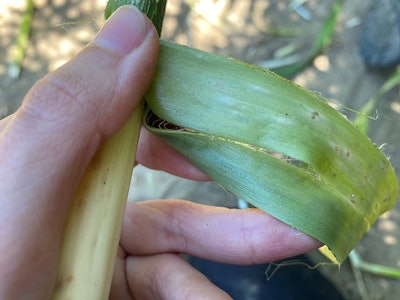
Boone chalks up disappointing market maturation to limited processing capacity and high prices for crops that compete with fiber hemp for land, but there’s good news. “What processors are operating are having no trouble selling their production, which is promising,” Boone says. He adds that some processors struggle to procure quality volume, settling on low-quality repurposed stalks from CBD crops, which drives lower pricing.
Boone says quality bast fiber’s effect on pricing is yet to be seen. “We are still in the early stages of how this will impact the market,” he says, adding that known quality material is typically procured quickly or already under contract.
California Fiber’s Future
“When people talk about anything from the flower—isolates, extracts, things like that—none of those are as complicated as making a textile,” Serbin says. It takes multiple industries working together to see hemp fibers become fabric. With much of the needed infrastructure and market now overseas, domestic infrastructure and fiber production depend on each other.
With the foundation for future California fiber crops laid, Pires plans to keep cultivating hemp and finessing the cotton gin he’s converting to process fiber hemp. “We’ve kind of got to jump on this thing I feel at this point, because we’ve already got the experience on the farming side and processing. We’re ahead of the game,” he says.
Serbin hopes to expand and work with more California farmers this season, but he hasn’t finalized his plans.
He acknowledges that a “Made in the USA” label has long been important to people, including him. “But it’s not always as important as how much something costs,” he adds. To date, most of the hemp fabric sold by Hemp Traders is imported from China, the leading textile producing and exporting country in the world—and a major importer of fiber hemp to create those textiles.
“What I’d love to do is get the hemp growing here in California, be able to separate it, sell the [hurd] here in the U.S., and send the long fiber to China to have them make textiles from that. And they want that,” he says. By shipping long fiber to China and capitalizing on that nation’s established textile industry, Serbin feels U.S. growers — and textile traders — would maximize profits at both ends.
With three decades of hemp industry expertise framing his view of the future, Serbin says it comes down to what he can do and what the industry will do.
Looking forward, he believes the data from the 2021 Central Valley trials will help California farmers be able to grow and sell fiber hemp profitably. “I anticipate there will be enough demand for that fiber that we’ll be able to grow lots of hemp around here,” he says.
As hemp cultivation increases and economies of scale set in, he expects production costs to fall. He hopes that will, in turn, open more industries and increase demand for U.S.-grown long fiber, domestically and internationally. Boone repeats that scenario, adding that taking care of hemp farmers is crucial to U.S. fiber hemp’s long-term success.
To competitively sell fiber hemp, Serbin says farmer and processor must benefit from a crop’s bast fiber and hurd. “In order for this to be profitable, you want to try to get the most for both of them,” he says. “And the way you’re going to get the most for the bast fiber is to sell it into the textile industry.”
Jolene Hansen is a freelance writer specializing in the hemp, horticulture and specialty agriculture industries. Reach her at [email protected]

